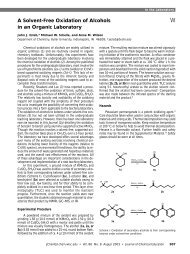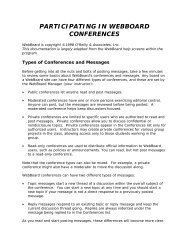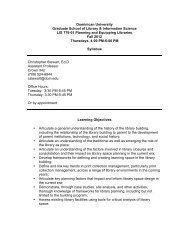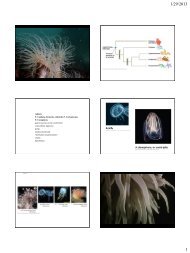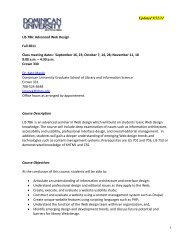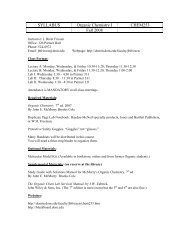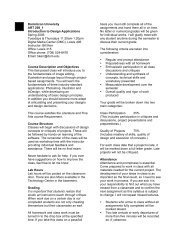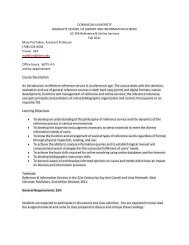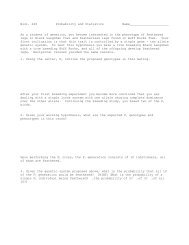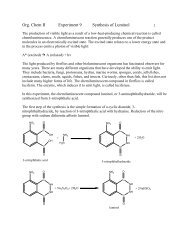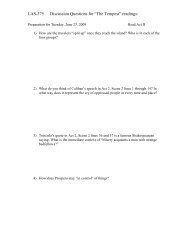Dehydration of Methylcyclohexanol
Dehydration of Methylcyclohexanol
Dehydration of Methylcyclohexanol
You also want an ePaper? Increase the reach of your titles
YUMPU automatically turns print PDFs into web optimized ePapers that Google loves.
Experiment 9 <strong>Dehydration</strong> <strong>of</strong> <strong>Methylcyclohexanol</strong> 1There are three distinct steps in most organic preparative reactions:1) the reaction itself,2) isolation <strong>of</strong> the crude product, and3) final purification.In some instances, as in the dehydration <strong>of</strong> an alcohol, it is necessary to combine the firsttwo steps so that the product can be removed from the reaction mixture as it is formed.This serves to drive the equilibrium toward alkene formation and to minimize thepossibility <strong>of</strong> oxidation or polymerization <strong>of</strong> the alkene.General <strong>Dehydration</strong> Reaction:H 2 CH 2 CH 2 CCH 2CH 2CHOHH 3 PO 4 , ΔH 2 CH 2 CH 2 CCHCH 2CH+ H 2 OThe phenomenon <strong>of</strong> steam distillation or hydrodistillation is observed in this experiment.Any water initially present in the mixture, and additional water formed us a result <strong>of</strong> thereaction, is immiscible with the alkene product. In the ethanol lab we learned that in amixture <strong>of</strong> two miscible liquids the total vapor pressure is the sum <strong>of</strong> the partial pressures<strong>of</strong> each component.There is a different situation in the distillation <strong>of</strong> a mixture <strong>of</strong> two compounds that are notmutually soluble. In this case each liquid exerts its own vapor pressure independently <strong>of</strong>the other.P Total = P° A + P° B P o Ais the vapor pressure <strong>of</strong> pure A at a particular temperatureAs long as separate phases are present in the liquid, the mixture will have a constantboiling point that is lower than the boiling point <strong>of</strong> either <strong>of</strong> the components. In addition,the distillate will have a constant composition, which is determined by the ratio <strong>of</strong> thevapor pressures.Vapor pressures <strong>of</strong> two immiscible compounds and their mixture as functions <strong>of</strong> the temperature.http://www.uwlax.edu/faculty/koster/Distillation305.htmBased on Experiment 12 “The <strong>Dehydration</strong> <strong>of</strong> <strong>Methylcyclohexanol</strong>s” in Palleros, D. R.(2000). Experimental organic chemistry. New York: Wiley.
Experiment 9 <strong>Dehydration</strong> <strong>of</strong> <strong>Methylcyclohexanol</strong> 2Practical advice for distillations: (Zubrick chapter 20)1. Always put several boiling chips in the distilling flask. Otherwise your liquid will boilover and shoot out <strong>of</strong> your condenser without bothering to vaporize first. Never dropa boiling stone into hot liquid, or you may be rewarded by having your body soakedin the hot liquid as it foams out at you.2. Don't fill the distilling flask more than half full. The liquid needs room to boil. Againwe are trying to avoid the dreaded boiling over phenomenon.3. Make sure the joints are snug. Greasing them helps them to hang together but theymust also be lined up properly.4. Use clamps! A distillation setup should be held with at least two clamps andpreferably three.5. Be sure you can remove the heat source quickly if you need to. Prop up the thermwellon something that you can remove if the dreaded boiling over phenomenon begins toexert itself.6. Be sure the thermometer bulb is below the side arm <strong>of</strong> the three-way adapter.7. Always keep cold water running in the condenser. Remember the water should go inthe bottom and out the top.8. Do not make you apparatus airtight. If you do, it will quite simply explode.9. Boiling point means "boiling range" just like with a melting point.10. Ideally the receiving flask should be in an ice and water bath.
Experiment 9 <strong>Dehydration</strong> <strong>of</strong> <strong>Methylcyclohexanol</strong> 46. Drain out the lower (aqueous) layer and discard it.7. Transfer the crude organic product (top layer) to a clean dry 50-mL Erlenmeyer flaskand add a teaspoon <strong>of</strong> anhydrous magnesium sulfate (MgSO 4 ) or sodium sulfate(Na 2 SO 4 ) to cover the bottom <strong>of</strong> the flask. Seal the flask with a cork or Al foil andallow it to stand for at least 10 minutes. Swirl the contents occasionally.8. Filter out the solid (gravity filtration) and record the mass <strong>of</strong> your liquid product.D. Verification <strong>of</strong> Identity and PurityUse refractive index, IR spectroscopy, and/or gas chromatography to determine thecomposition and purity <strong>of</strong> your product.E. Qualitative test:Put two drops <strong>of</strong> 5% Br 2 in dichloromethane in a test tube.Note its colorAdd your product to the test tubes dropwise with shaking.What do you observe?F. Clean up.1. Hand in a properly labeled sample <strong>of</strong> your product:your namedatelab titleproduct identity2. Dispose <strong>of</strong> liquid waste in the liquid waste containerHow <strong>of</strong>ten have I said to you that when you have eliminated the impossible,whatever remains, however improbable, must be the truth.Sir Arthur Conan Doyle, The Sign <strong>of</strong> Four, Ch. 6
Experiment 9 <strong>Dehydration</strong> <strong>of</strong> <strong>Methylcyclohexanol</strong> 6Experimental Observations and Data:Hand in a copy <strong>of</strong> your experimental observations and data before you leave lab.Experimental Observations.___ Appearance <strong>of</strong> reagents?___ Record the mass (to the nearest 0.01 gram) <strong>of</strong> your alcohol.___ What temperature changes did you observe during distillation?___ How long did the distillation take?___ What did your product look like?___Compare your starting alcohol with the crude distilled product and the final product.___ What is the appearance <strong>of</strong> the distilling flask at the end <strong>of</strong> the reaction?___ Did you record interesting sights and smells?Data:___ Did you record the mass <strong>of</strong> your product?___ What data did you collect from parts D. and E.?Results.Lab Report Checklist:____ % yield <strong>of</strong> product crude product mass x 100/theoretical yieldDiscussion and Conclusion.____ Was your percent yield acceptable? Explain why it was lower (or higher) than expected.____ Did you obtain your predicted product? Explain using all relevant data.____ Comment on the purity and composition <strong>of</strong> your product.Explain using all relevant data.Justify the presence <strong>of</strong> side reaction products.____ What is going on in the qualitative test? Include at least one chemical structure.____ Green Question: What common beverage contains phosphoric acid?



